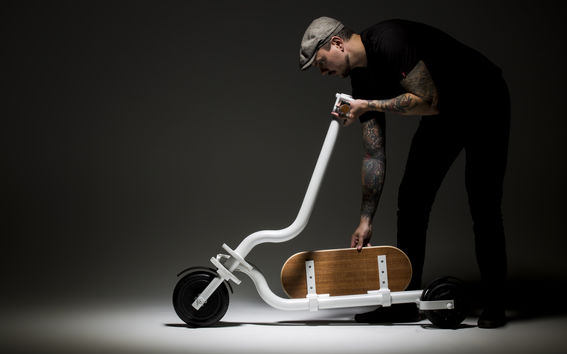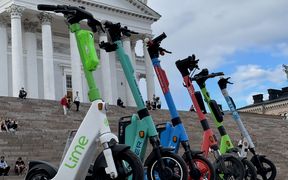How will e-scooters transform urban spaces?

You might see them by your bus stop, blocking a door or zooming past as you cross the road. E-scooters have joined the cityscape – and have changed how we move around.
‘What we can see around the world is that e-scooters have disrupted the existing landscape of urban mobility modes,’ says Samira Dibaj, a doctoral student researching how e-scooters are used. She explains that how people use e-scooters depends on the context, including the wider urban built environment and existing transport infrastructure.
Case in point: how e-scooters are used in European cities with well-developed public transport systems differs from how they are used in US cities that lack such services. ‘We see that e-scooters are used in both functional and fun ways,’ Dibaj says. Leisure trips are the main use in both the US and Europe, she explains, but e-scooters substitute for taxis or ride-hailing services in US cities, while in European cities they usually replace bus or tram use.
Eco-friendly transport or an option for the young and well?
Whether environmental and social benefits will come out of e-scooters largely depends on how they’re used and how they fit into the urban mobility landscape. E-scooters are part of a change in transportation known as micromobility, in which short daily trips are made using lightweight vehicles like bicycles instead of cars.
‘E-scooters could contribute to reducing overall noise pollution and carbon emissions in cities – if they replace car driving and not walking,’ says Samira Dibaj.
In the end, all the actors involved – companies, residents and municipalities – influence the role that scooters will take. Nitin Sawhney, a professor of practice who studies responsible AI and participatory design, explains that public and private actors can have very different priorities, leading to certain risks: tools that aren’t designed with accessibility in mind may exclude certain users, and economic factors can also restrict access or exclude certain groups.
‘That’s the bigger arc that we should think about. People say that micromobility is a technology that takes us to the last mile, but we have to ask “The last mile for who?”’ says Sawhney.
‘The claim is that e-scooters offer a new platform, but they don’t actually expand mobility for people who couldn’t use current options, like the elderly, disabled people or young children – groups that don’t currently use e-scooters. And we have to ask why they don’t and what other mobility alternatives would suit them.’
Why jump on board?
At the moment there is no clear understanding of why and how people use e-scooters – aside from the very basics.
‘Relying on usage data from e-scooters is very myopic,’ says Nitin Sawhney. ‘We need to expand the richness of the data we’re gathering. We can conduct interviews and qualitative analysis about things like quality of life, ethnographic data, and people’s perceptions and interests.’
Dibaj was part of a team collecting such data during the summer to understand the hows and whys of e-scooter use. They are also hoping to learn whether and when the devices are used in place of other forms of transport, as well as why some people stop using e-scooters or haven’t tried them at all.
‘I’m trying to understand not just the technology but also the mutual reshaping of technology and society – which of course can have both positive and negative consequences for that very society,’ explains Dibaj. ‘At the root of this thinking is the need to develop a human-centred problem-solving approach.’
Miloš N. Mladenović, assistant professor of transportation engineering who is supervising Dibaj, says the findings should ultimately benefit all involved, who together need to manage the interaction between technology and society.
‘Ultimately, emerging technologies such as e-scooters are like a mirror for society, revealing deeper structural challenges we have to face in the long term – such as the climate crisis and social inequality,’ Mladenović says.
Citizens of the future
To make it all work, good governance and participatory processes around e-scooters and micromobility must be in place. All actors and affected groups need to have their voices heard and be able to access and understand the decision-making process and the data driving it. E-scooters also affect people who don’t use them – for example, unused scooters on paths or sidewalks are in the way of people with mobility challenges – and those groups need to be heard.
A city is a shared space, and its design should support the needs of all its residents. Private companies have made e-scooters a commonplace sight, but without input and oversight from public planners, advocacy groups and others, the result will be a system tailored to consumer desires instead of public needs.
Everyone would benefit if e-scooter data were shared – responsibly – with municipalities, explains Nitin Sawhney. Despite the shortcomings of a purely quantitative approach, such data is valuable to urban planners, who help bring cities to life.
‘Urban mobility data can contribute to better urban planning and modelling. It can tell a lot about the patterns of movement in a city and how pathways for urban mobility can be better designed. It can allow for conversation about urban futures.’
In the end, e-scooters and similar technologies pose a number of questions, from what data we use and how we manage it to the responsibilities of various actors and how different groups are included in decision-making. For Samira Dibaj, they are just one part of a bigger picture.
‘We need to understand many complex interactions and details to really understand why humans behave in a certain way,’ she says.
‘This work requires me not only to think in a conceptually different way but also to rely on different methods for understanding people. For me, this is just the beginning of a long journey in understanding human behaviour.’
Text: Sedeer el-Showk
Photo: Jukka Jokinen
This article has been published in the Aalto University Magazine issue 31 (issuu.com), October 2022.
Samira Dibaj‘E-scooters could contribute to reducing noise pollution and carbon emissions in cities – if they replace car driving and not walking.’
Additional measures are needed to manage the use of electric scooters
According to a recent report, Finland should consider age, speed and alcohol limits for the use of electric scooters and other means of micromobility.

Read more news

Your voice gives away valuable personal information, so how do you keep that data safe?
With speech technologies becoming increasingly common, researchers want to make sure we don’t give away more information than we mean to.
Aalto in 2025: Quantum leaps, creative breakthroughs and solutions for a better life
Growth, technology and industrial renewal; human-centred solutions; health and everyday wellbeing; and enjoyable daily life and thriving communities.
Research Council of Finland establishes a Center of Excellence in Quantum Materials
The Centre, called QMAT, creates new materials to power the quantum technology of coming decades.






